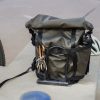Introduction
Backpacks are a daily necessity for many, enduring the rigors of travel, work, and school. Over time, they accumulate dirt, sweat, and stains, necessitating a thorough cleaning. However, washing backpacks in washing machines can be daunting, as improper care can damage both the machine and the backpack. This article explores professional advice on safely and effectively washing backpacks in washing machines, preserving the longevity and appearance of this essential accessory.

I. Assessing the Suitability for Machine Washing
Not all backpacks are created equal when it comes to machine washing. Experts in textile care stress the importance of checking the manufacturer’s label for cleaning instructions. Materials like leather or backpacks with metal frames are generally not suitable for machine washing and require alternative cleaning methods.
II. Pre-Washing Preparations
Before tossing a backpack into the washing machine, there are several preparatory steps recommended by professionals:
Emptying the Backpack
Ensure all pockets are emptied and check for any items that could be damaged or cause damage during the wash cycle.
Removing Loose Dirt and Debris
Shake out any loose dirt and use a soft brush or vacuum attachment to remove debris from the fabric’s surface, as advised by cleaning specialists.
Treating Stains
Pre-treating stains with a gentle stain remover or a mixture of water and mild detergent can improve the effectiveness of the wash, as noted by laundry experts.
Detaching Removable Parts
Any removable straps or covers should be detached and washed separately to prevent damage, according to professional organizers.
III. Washing Backpack in Washing Machine: The Process
Choosing the Right Settings
Laundry professionals recommend using gentle cycle settings with cold water to prevent damage to the backpack’s fabric and structure.
Using a Protective Bag
Placing the backpack in a laundry bag or pillowcase can help protect the bag and the washing machine from zippers and buckles during the cycle.
Selecting an Appropriate Detergent
A mild detergent is suitable for most backpacks, while technical fabrics used in outdoor gear may benefit from specialized cleaners, as per textile care experts.
Balancing the Load
To avoid unbalancing the washing machine, it’s important to add a few towels or other soft items, ensuring an even distribution of weight during the spin cycle.
IV. Post-Wash Care and Drying
After the wash cycle is complete, proper drying is crucial to prevent mold and mildew. Air drying is the preferred method, with professionals advising against the use of dryers which can damage the backpack’s fabric and structure. Hanging the backpack upside down ensures that water drains out, and all compartments and pockets should be left open to air out thoroughly.
V. Maintaining Backpack Condition Post-Wash
Once the backpack is dry, experts suggest reapplying any water-repellent treatments if the backpack is designed for outdoor use. This maintains the fabric’s protective properties and prepares the backpack for future use.
VI. Professional Perspectives on the Longevity of Washed Backpacks
Material Preservation
Textile industry professionals emphasize the role of proper washing in preserving materials. Gentle wash cycles and natural drying methods help maintain the integrity of the fibers, zippers, and seams.
Frequency of Washing
Over-washing can lead to wear and tear, so it’s advisable to wash backpacks only when necessary. A good rule of thumb provided by fabric care professionals is to wash backpacks once a semester for students or after each significant trip for travelers.
VII. Alternative Cleaning Methods
For backpacks that are not machine washable, alternative cleaning methods are recommended. Spot cleaning with a damp cloth and mild detergent, as well as specialized cleaning products for leather or other delicate materials, are options to consider, often endorsed by luxury goods caretakers.
VIII. Conclusion
Washing backpacks in washing machines can be a safe and efficient way to keep your gear clean, provided the appropriate precautions and methods are followed. By adhering to expert advice and best practices, one can ensure that backpacks are not only clean and fresh but also well-maintained for continued use. It’s essential to remember that the key to longevity is a combination of careful cleaning, proper maintenance, and judicious use of washing machines, ensuring that your backpack remains a reliable companion for all your adventures.

